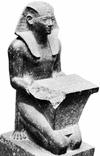- Amenhotep II
-
flourished 15th century BCEgyptian pharaoh (r. 1514–1493 BC), son and successor of Ahmose I. Amenhotep extended Egyptian rule southward to the Third Cataract of the Nile while also maintaining rule in the northeast.He pioneered the transition away from pyramidal tombs to rock-cut tombs in the Valley of the Kings in western Thebes. The royal mortuary temples were erected at the edge of the desert during his reign, though the location of his own tomb is unknown.
 Amenhotep II offering sacrifices, statue, 15th century BC; in the Egyptian Museum, CairoBy courtesy of the Egyptian Museum; photograph, Hirmer Fotoarchiv, Munchen
Amenhotep II offering sacrifices, statue, 15th century BC; in the Egyptian Museum, CairoBy courtesy of the Egyptian Museum; photograph, Hirmer Fotoarchiv, Munchen* * *
▪ king of Egyptalso called Amenophis IIking of ancient Egypt (Egypt, ancient) (reigned c. 1426–00 BCE), son of Thutmose III. Ruling at the height of Egypt's imperial era, he strove to maintain his father's conquests by physical and military skills.Amenhotep II's upbringing was carefully guided by his warrior father, with great emphasis on physical strength, skills of warfare, and sportsmanship. Amenhotep never tired of boasting of his feats in these skills, and he was even buried with his great bow.Amenhotep's first campaign was against uprisings in northern Syria, during which he extracted loyalty oaths from other Asiatic princes. Returning from Asia, he forwarded the body of a rebel Asiatic chief to the Nubian capital, where it was hung on the town wall as an example. His second campaign was less ambitious, reaching only to the Sea of Galilee (Galilee, Sea of), but after it Amenhotep received gifts from Mitanni, Babylon, and the Hittites (Hittite). No further northern wars occurred, which suggests that a balance of power had been achieved.Within Egypt, many of his father's administrators continued to serve Amenhotep, and the king completed some buildings begun by Thutmose III. He also built a number of new sanctuaries in Upper Egypt and Nubia and added his mortuary temple in western Thebes. Amenhotep's mummy was discovered in the Valley of the Kings (Kings, Valley of the) at Thebes, in his fine well-preserved tomb, which had been used as one of the caches for the safekeeping of royal mummies that had been reembalmed in the 21st dynasty (Egypt, ancient) (1075–c. 950 BCE) following the closure of the Valley of the Kings.* * *
Universalium. 2010.
